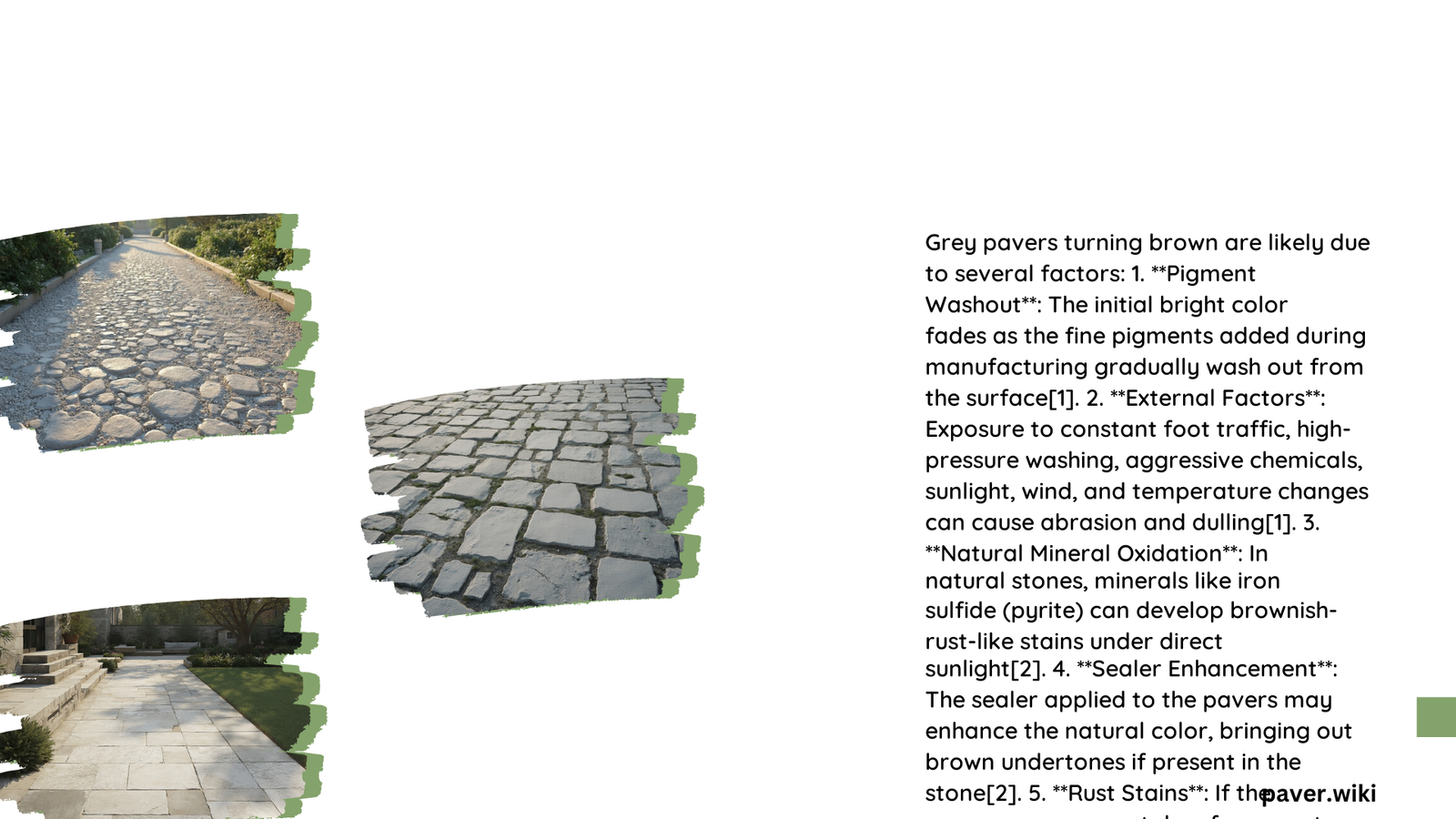Grey pavers turning brown is a common issue faced by many homeowners and property managers. This discoloration can be caused by various factors including UV exposure, moisture, pollution, and chemical interactions. Understanding the causes and implementing proper maintenance techniques can help prevent this problem and maintain the aesthetic appeal of your pavers. This article explores the reasons behind grey paver discoloration, effective prevention methods, and solutions for restoring affected pavers.
Why Are My Grey Pavers Turning Brown?
The transformation of grey pavers to a brown hue is often the result of several environmental and chemical factors:
- UV Exposure: Prolonged exposure to sunlight can cause the pigments in pavers to fade and change color over time.
- Moisture Retention: Excess moisture can lead to the growth of mold, mildew, and algae, which can discolor pavers.
- Air Pollution: Airborne particles and pollutants can interact with paver pigments, causing discoloration.
- Chemical Reactions: Harsh chemicals like bleach, vinegar, and deicing salts can strip away pigments and reveal the underlying aggregate.
- Temperature Fluctuations: While not directly causing discoloration, temperature changes can lead to cracks that make pavers more susceptible to staining.
How Can I Prevent My Grey Pavers from Turning Brown?

Preventing grey pavers from turning brown involves regular maintenance and protective measures:
1. Regular Cleaning
- Use gentle, biodegradable detergents without bleach or acids
- Maintain a cleaning schedule to prevent buildup of dirt and organic matter
2. Proper Sealing
- Apply a high-quality sealer every 1-3 years
- Choose sealers that offer UV protection and water resistance
3. Drainage Improvement
- Ensure proper drainage to prevent water accumulation on pavers
- Address any areas with poor drainage to reduce moisture retention
4. Chemical Avoidance
- Avoid using harsh chemicals for cleaning or deicing
- Opt for paver-safe alternatives when necessary
What Are the Costs Associated with Restoring Brown Pavers?
Restoring pavers that have turned brown can involve several costs:
| Service | Cost Range |
|---|---|
| Professional Cleaning | $0.50 – $2.00 per square foot |
| Sealing Products | $0.10 – $0.50 per square foot |
| Application Costs | $0.50 – $1.50 per square foot |
The time required for restoration can vary from a few hours for small areas to several days for larger spaces. Professional services may charge hourly rates ranging from $50 to $150.
What Are Effective Preventive Measures Against Grey Paver Browning?
To effectively prevent grey pavers from turning brown, consider the following measures:
1. Choose the Right Sealant
- Acrylic Sealants: Water-based, easier to apply
- Polyurethane Sealants: Oil-based, more durable, enhance color
2. Proper Application Methods
- Apply thin layers of sealant
- Allow each layer to dry before applying the next
- Ensure pavers are clean and dry before sealing
3. Ideal Application Conditions
- Apply sealants in temperatures between 50°F and 90°F (10°C and 32°C)
- Avoid direct sunlight and high humidity during application
- Ensure pavers are free from moisture and debris
How Often Should I Clean and Seal My Grey Pavers?
Regular maintenance is crucial for preventing grey pavers from turning brown:
- Cleaning Frequency:
- Light traffic areas: Every 6-12 months
-
High traffic areas: Every 3-6 months
-
Sealing Frequency:
-
Every 1-3 years, depending on traffic and exposure
-
Inspection Schedule:
- Conduct visual inspections every 3-4 months
- Look for signs of discoloration, staining, or damage
What Are the Best Cleaning Products for Grey Pavers?
Choosing the right cleaning products is essential for maintaining the color of grey pavers:
- pH-Neutral Cleaners: Use cleaners with a pH close to 7 to avoid damaging the pavers
- Specialized Paver Cleaners: Look for products specifically designed for concrete pavers
- Oxygen Bleach: A safer alternative to chlorine bleach for removing organic stains
- Biodegradable Degreasers: For areas with oil or grease stains
Avoid using:
– Harsh acids or alkaline cleaners
– Chlorine bleach
– Vinegar or other household acids
How Can I Restore the Color of My Brown Pavers?
If your grey pavers have already turned brown, you can restore their color through the following steps:
- Deep Cleaning:
- Use a pressure washer with appropriate pressure settings
- Apply a specialized paver cleaner
-
Scrub stubborn stains with a stiff brush
-
Stain Removal:
- Use targeted stain removers for specific types of discoloration
-
Allow sufficient dwell time for the products to work
-
Color Restoration:
- Consider using a color-enhancing sealer
-
For severe cases, consult a professional about color restoration products
-
Resealing:
- Apply a high-quality sealer after cleaning and color restoration
- Choose a sealer that offers UV protection and enhances the paver color
By following these guidelines and maintaining a regular cleaning and sealing schedule, you can prevent grey pavers from turning brown and maintain their original appearance for years to come.
References:
1. Parsons Rocks: Three Reasons Your Paver Patio Stones Fade and How You Can Stop It
2. Aviara Pavers: Why Do My Pavers Look Dull?
3. DJL Services: What’s That stain? Your guide to identifying Paving Stains and Paving Cleaning
